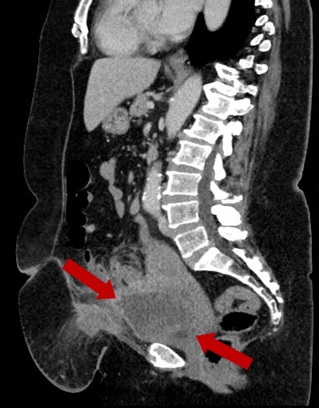Urachal adenocarcinoma: a rare clinical presentation
Conteúdo do artigo principal
Resumo
Urachal tumor is extremely rare, since it is responsible for about 0.01% of all neoplasms already repeated in the history of clinical oncology, with the adenocarcinoma subtype being the most prevalent. Thus, the present work aims to report a case of a 55-year-old patient diagnosed with urachal tumor, relating the clinical presentation of the case according to current literary data. It was possible to show that such a diagnosis, as well as the institution of a standard treatment, is still a clinical challenge in modern medical practice.
Detalhes do artigo

Este trabalho está licenciado sob uma licença Creative Commons Attribution 4.0 International License.
Authors retain the copyright of their articles and grant the journal the right of first publication under the Creative Commons Attribution (CC BY) license, which allows others to share and adapt the work with proper attribution.
Referências
Costa TM, Santana RM, Souza AF, et al. Adenocarcinoma de úraco: relato de caso de um tumor incidental. Urominas. 2016;3(7):56-8.
Cruz CLP, Fernandes GL, Natal MRC, et al. Neoplasia de úraco: relato de caso. Radiol. bras. 2014;47(6):387-8. https://doi.org/ 10.1590/ 0100-3984.2013.1879
NeuUro. Tumores de Úraco [Internet]. 2011 [cited 2021 Mar 17]. Available from: http:// neouro.com.br/ tratamentos/ tumores-de-uraco/
García Salazar N, Pérez Silva MM, et al. Carcinoma de úraco, una neoplasia maligna poco frecuente. Rev. méd. Urug. (En línea). 2018;34(1):124-33. http://dx.doi.org/10.29193/rmu.34.1.6
Planelles Gómez J, Olmos Sánchez L, Sánchez Cuallado C, et al. Adenocarcinoma de úraco: presentación de dos casos. Rev. chil. Urol. 2018; 83(1):44-8.
Silva CD, Quinta A, Oliveira M, et al. Carcinoma de úraco. Acta Urológica. 2009;26(2):164.
Hamilou Z, North S, Canil C, et al. Management of urachal cancer: a consensus statement by the Canadian Urological Association and genitourinary medical oncologists of Canada. Can Urol Assoc J. 2020;14(3):E57. doi: 10.5489/cuaj.5946
Sheldon C, Clayman R, González R, et al. Signet-Malignant urachal lesions. J Urol. 1984;131(1):1-8. https://doi.org/10.1016/S0022-5347(17)50167-6
Barrientos SL, Poblete MT. Carcinoma de uraco. Cuad. Cir. 2000; 14:27-32.
Zeman M, Silver E, Akin E. CT and PET Findings for Urachal Adenocarcinoma: A Case Report. Ann Clin Case Rep. 2017; 2:1252.
Kumar N, Khosla D, Kumar R, et al. Urachal carcinoma: Clinicopathological features, treatment and outcome. J Cancer Res Ther. 2014;10(3):571-4.
National Comprehensive Cancer Network (NCCN) Clinical Practice Guidelines in Oncology (NCCN Guidelines®) – Bladder Cancer. 2021. [cited 2021 Mar 17]. Available from: https://www.nccn.org/professionals/physician_gls/default.aspx
Wein, AJ, Kavoussi LR, Novick AC, et al. Campbell Walsh Urology. Neuropathic dysfunction of the lower urinary tract. 4th ed. USA: Elsevier Saunders; 2011.
Vogelzang NJ, Scardino PT, Shipley WU, et al. Comprehensive Textbook of Genitourinary Oncology. 3rd ed. Philadelphia: Wolters Kluwer Health/Lippincott Williams & Wilkins; 2011.
Koster IM, Cleyndert P, Giard RW. Best cases from the AFIP: urachal carcinoma. Radiographics. 2009; 29(3):939-42. https:// doi.org/ 10.1148/rg.293085152
Peugniez C, Ghoneim T, Leroy X, et al. Les cancers de l’ouraqueUrachal cancers. Bull Cancer. 2013;100(5):509–17. doi: 10.1684/bdc.2013.1718
Siefker-Radtke A. Urachal adenocarcinoma: A clinician’s guide for treatment. Semin Oncol. 2012;39(5):619–24. doi: 10.1053/j.seminoncol.2012.08.011
Jung HA, Sun JM, Park SH, et al. Treatment outcome and relevance of palliative chemotherapy in urachal cancer. Chemotherapy. 2014;60(2):73–80. doi: 10.1159/000368071
Kikuchi M, Kamei S, Morirama Y, et al. Case of urachal cancer treated by neoadjuvant chemotherapy with FOLFOX4 (oxaliplatin, 5-FU and leukovolin). Hinyokika Kiyo. 2008;54(8):557–9. PMID: 18788447
Kume H, Tomita K, Takahashi S, et al. Irinotecan as a new agent for urachal cancer. Urol Int. 2006;76(3):281–2. doi: 10.1159/000091635
Siefker-Radtke AO, Gee J, Shen YU, et al. Multimodality management of urachal carcinoma: The M.D. Anderson Cancer Center experience. J Urol. 2003;169(4):1295–8. doi: 10.1097/ 01.ju.0000054646.49381.01
Galsky MD, Iasonos A, Mironov S, et al. Prospective trial of ifosfamide, paclitaxel, and cisplatin in patients with advanced non-transitional cell carcinoma of the urothelial tract. Urology. 2007;69(2):255-9. doi: 10.1016/j.urology.2006.10.029
Hong JY, Choi MK, Uhm JE, et al. Palliative chemotherapy for non-transitional cell carcinomas of the urothelial tract. Med Oncol. 2009;26(2): 186–92. doi: 10.1007/s12032-008-9106-7
Goss G, Hirte H, Miller WH Jr, et al. A phase 1 study of oral ZD 1839 given daily in patients with solid tumors: IND.122, a study of the Investigational New Drug Program of the National Cancer Institute of Canada Clinical Trials Group. Invest New Drugs. 2005; 23(2):147–55. doi: 10.1007/ s10637-005-5860-y
Le DT, Uram JN, Wang H, et al. PD-1 blockade in tumors with mismatch-repair deficiency. N Engl J Med. 2015;372(20):2509–20. doi: 10.1056/ NEJMoa1500596
Ashley RA, Inman BA, Sebo TJ, et al. Urachal carcinoma: clinicopathologic features and long-term outcomes of an aggressive malignancy. Cancer. 2006;107(4):712-20. https:// doi.org/ 10.1002/cncr.22060
Esteves FP, Pinto AC, Pinto AFC. Urachal adenocarcinoma. Braz J Urol. 2001;27(6):560-2.
